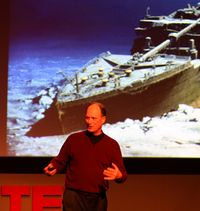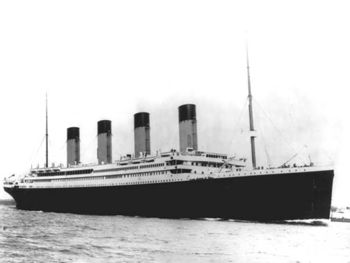RMS Titanic
RMS[1] Titanic was a passenger liner that sank on its maiden voyage in April 1912 after it struck an iceberg in the North Atlantic Ocean. Although never officially named as "unsinkable", it was believed at the time that the Titanic's design would reduce the likelihood of such a disaster.
Titanic, along with its very similar sister ships Olympic and Britannic, was a British vessel built in Belfast at the Harland and Wolff shipyard for the White Star Line. It left Southhampton, England, on 10th April 1912, bound for New York via France and Ireland. After striking an iceberg late on 14th April, the ship sank in the early hours of the following day with the loss of 1,514 passengers and crew. Titanic had too few lifeboats for the more than 2,200 people on board, and many boats left with empty spaces due to a general failure to recognise the danger until it was too late.
The iceberg opened a gash in Titanic's starboard (right) side, flooding compartments along the hull. The bow started to sink first; pressure further down the length of the ship led it to split towards the stern section. The remains of the ship lie in two main pieces two-and-a-half miles (four kilometres) below the surface.
The loss of the Titanic is the world's best known maritime disaster, and forced a rethink of ship design and other safety measures. The wreck was rediscovered in the 1980s and since then various artefacts have, sometimes controversially, been raised.
Construction
RMS Titanic was commissioned in 1907 and built from 1909 at the Harland and Wolff shipyard in Belfast, today in Northern Ireland, by a workforce of over 3,000 people over two years. By the time it was finished in 1912, eight men had been killed in construction accidents, including one on launch day. Titanic was then the largest artificial object in the world, 882ft, 8in (268m) long and 92ft (28m) wide, and similar in its dimensions to its sister ships, the earlier Olympic and the later Britannic.
Titanic had four funnels, the last actually being a false one that aided ventilation and was also used for storage. The ship also boasted a series of 16 compartments along the hull that would, it was believed, prevent the ship sinking as long as only up to four of them were flooded. First-class passengers could make use of rich-appointed cabins and other lavishly-decorated rooms, though the ship's interiors were no more luxurious than those of its competitors. It was also not the fastest vessel put to sea at the time, with a maximum of about 23 knots (about 27mph).
Voyage
Titantic, under the captainship of Edward Smith, left Southhampton, England, on 10th April 1912 on its maiden voyage, bound for New York via Cherbourg, France and Cobh, Ireland. From Ireland, the ship made its way out into the North Atlantic Ocean and towards an area known for ice. By the evening of 14th April, the ship was heading at speed towards its final destination when it struck an iceberg.
Sinking
Frederick Fleet, a lookout on-board the Titanic, spotted the iceberg dead-ahead but his warning came too late. Titanic was shifted towards port (leftwards), but its starboard side scraped along the side of the iceberg, opening a gash and flooding hull compartments. Survivors late described the experience of several bumps, but at this stage, approximately 11:40pm on 14th April, there was little alarm. One first-class passenger, Edith Russell, recalled that she went immediately to the promenade deck to view the iceberg as it shook ice onto the ship, before joining other passengers in using it for a snowball fight.[2]
...She went down as far as the afterfunnel, and then there was a little roar, as though the engines had rushed forward, and she snapped in two, and the bow part went down and the afterpart came up and staid up five minutes before it went down.
|
Over the next few hours, the ship took on more and more water towards the bow section, which started to sink first. This put tremendous pressure further down the length of the ship and led it to split towards the stern section. This stayed afloat for a few minutes before also sinking in the early hours of 15th April, with the loss of 1,514 passengers and crew. Titanic had too few lifeboats for the more than 2,200 people on board, and many boats left with empty spaces due to a general failure to recognise the danger until it was too late.
Aftermath
Official inquiries
The ship went down gradually by the bow, assuming an almost perpendicular position just before sinking at 12.47 a.m., New York time, April 15. There have been many conflicting statements as to whether the ship broke in two, but the preponderance of evidence is to the effect that she assumed an almost end-on position and sank intact.
|
The sinking was the subject of two separate inquiries either side of the Atlantic, one by the United States Senate and the other by the British Wreck Commissioner. Eyewitness and other testimonies were heard from, respectively, 19th April and 2nd May. As many survivors had been taken to the USA, the American inquiry went ahead first, at the Waldorf-Astoria Hotel in New York, for an 18-day period. The British inquiry was held over 36 days, and both inquiries produced detailed reports, including transcripts of witness testimonies. The disaster led to a lengthy series of safety recommendations; for example, the US committee demanded that all vessels carry sufficient lifeboats.[3] As for the cause of the disaster, the Wreck Commissioner concluded that the Titanic had sunk due to a collision with an iceberg while travelling at excessive speed.[4]
In response to the loss of Titanic, the International Convention for the Safety of Life at Sea (SOLAS) was created in 1914 to introduce new maritime safety procedures.[5]
Rediscovery

Robert Ballard, the oceanographer who rediscovered the Titanic, delivering a lecture about the ship at the 2008 TED conference.
The remains of the ship lie in two main pieces two-and-a-half miles (four kilometres) below the surface. It was rediscovered by oceanographer Robert Ballard in 1985, who was being secretly funded by the US Navy to find two of its wrecked submarines; Ballard took the opportunity to also locate the Titanic.[6] Since then, various artefacts have been raised, ignoring Ballard's view that the site should be protected as a grave and historical site.[7]
Legacy
The Titanic disaster has proven to be fertile ground for the imaginations of everyone from film producers to conspiracy theorists, and interest in its story increased around the time of the 100th anniversary of the sinking. The National Geographic Society, for example, showcased new and highly-detailed photographs of the wreck in its magazine,[8] and other publications and broadcasts were made available around the world.[9] Memorial cruises were also planned to the site of the sinking, though one such trip suffered some troubles en route, which some commentators viewed as an omen.[10]
Film
There have been several films abut Titanic, ranging from a 1943 Nazi propaganda exercise, to the acclaimed A Night to Remember and the 1997 big-budget take on the tragedy, directed by James Cameron. The 1997 film was the first major production to depict the vessel splitting into two pieces as it sank; previous productions had not shown this because the British and American inquiries into the disaster recorded that the ship had gone down intact, despite some eyewitness accounts to the contrary, and this erroneous version of events persisted for decades.[11]
Conspiracy theories and other claims
Perhaps the most persistent conspiracy theory surrounding the Titanic tragedy is the idea that the ship was deliberately sunk as part of an insurance scam. This is sometimes referred to as the 'Titanic switch' because it also includes the claim that the name of the Titanic was swapped with that of its sister ship Olympic, and that therefore the 'real' Titanic sailed on for over 20 years of safe and reliable service while Olympic rested at the bottom of the Atlantic. Proponents of this view allege that, following a well-documented collision involving the Olympic a few years earlier, the owners of the vessels discovered that the Titanic's sister ship was far more damaged than publicly disclosed. Fearing that insurers would refuse to pay out, they opted to rename the ship, scuttle it, make this look like an accident and collect the insurance money. Evidence for any of this is limited and would have required the owners to recklessly endanger many people. The plot also stretches credulity since it would presumably have involved a great many people to be involved to have carried out and covered up the switch, who then all took the secret to their graves. Finally, analysis of the wreck itself has for most commentators put the theory to rest.
Various other claims about the sinking have popped up over the years, including an idea that a serious fire actually sank the vessel rather than the iceberg; the belief that an Ancient Egyptian mummy being transported onboard took the ship down with it as part of a curse; and the speculation that perhaps Titanic was sunk by the extra weight of time machines piloted by interested observers from the future materialising inside it.[12]
Footnotes
- ↑ Royal Mail Ship; the Titanic carried mail as well as passengers and other cargo.
- ↑ National Museums Northern Ireland: 'Titanic - Edith Russell'.
- ↑ Titanic Inquiry: 'United States Senate Inquiry - Recommendations', 1912.
- ↑ Titanic Inquiry: 'British Wreck Commissioner's Inquiry - Report of the Court', 1912.
- ↑ Internet Archive: 'Text of the Convention for the Safety of Life at Sea (1914)'. .pdf document.
- ↑ Daily Telegraph: 'Titanic search a cover for submarine mission'. 24th May 2008.
- ↑ IBN Live: 'Need to protect 'Titanic' for future: Bob Ballard '. 10th April 2012.
- ↑ National Geographic: 'Unseen Titanic - Photo Gallery'.
- ↑ New York Times: 'For a quickly doomed Ship, a very long afterlife'. 12th April 2012.
- ↑ Daily Mail: 'Titanic memorial cruise forced to turn round just hours after leaving dock'. 11th April 2012.
- ↑ Titanic Inquiry: 'United States Senate Inquiry - Ship Sinking' and 'British Wreck Commissioner's Inquiry', 1912.
- ↑ Randles, J. (1994). Time Travel: Fact, Fiction and Possibility.
